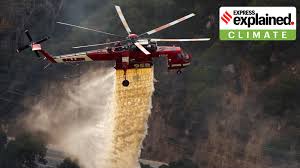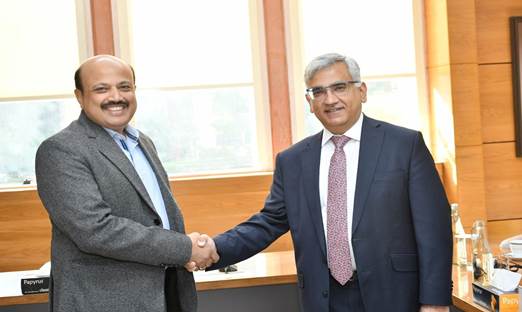Santa Ana Winds

- 15 Dec 2024
In News:
The ongoing Franklin Fire in Malibu, California, has burned over 4,000 acres and affected around 22,000 people. Although the exact cause of the fire is still under investigation, experts point to two key factors contributing to the intensity of the blaze: Santa Ana winds and climate change.
Santa Ana Winds
- Santa Ana winds are powerful, dry winds that typically occur in Southern California from October to January.
- They are caused when high-pressure systems over the Great Basin (the area between the Rocky Mountains and Sierra Nevada) push air toward low-pressure areas over California’s coast.
- As the air moves downhill through mountain passes, it compresses and heats up, which significantly lowers the humidity—sometimes to levels below 10%—creating dry conditions. This extremely low moisture content dehydrates vegetation, making it highly susceptible to combustion.
- These winds have been a natural feature of California's weather, contributing to wildfires for years. However, when combined with other factors like climate change, their impact has become more severe.
The Role of Climate Change
While Santa Ana winds have long played a role in California's wildfires, climate change has exacerbated the situation in recent years. The state's wildfire season has lengthened due to rising global temperatures, which have led to:
- Warmer springs and summers.
- Earlier snowmelt in spring, which leaves vegetation drier for longer periods.
- Longer and more intense dry seasons, which cause increased moisture stress on vegetation.
As a result, forests and brushlands are now more vulnerable to fires. Climate change has also contributed to more extreme weather events, including heatwaves, which further dry out vegetation and create favorable conditions for wildfires.
Intensification of Wildfire Seasons
Recent studies have shown that California's wildfire season has grown longer over the past two decades. For example, a 2021 study in Nature Scientific Reports found that the state's annual burn season has shifted, with the peak fire season now occurring earlier in the year, from August to July. Additionally, research published in PNAS (Proceedings of the National Academy of Sciences) in 2023 indicated that the largest wildfires in California history have occurred in the past 20 years, with five of the top 10 largest fires taking place in 2020 alone.
Looking Ahead
The situation is expected to worsen as climate change continues. If global temperatures rise by more than 3°C by the end of the century, as predicted by the United Nations, California’s wildfire risk will likely intensify. The combination of Santa Ana winds and increasingly dry conditions will continue to make areas like Malibu, and much of California, more prone to destructive wildfires.
In conclusion, while Santa Ana winds remain a natural contributor to California's wildfires, the influence of climate change has significantly lengthened the wildfire season, making wildfires more frequent, intense, and harder to control. The continued rise in global temperatures only accelerates these trends, posing a growing challenge for fire management and public safety in California.
'Jalvahak' Scheme for Inland Waterways Promotion

- 15 Dec 2024
In News:
Govt Unveils ‘Jalvahak’ To Boost Inland Waterways, Cargo Movement Incentivised on NW1, NW2 & NW16
Key Highlights:
- Launch of 'Jalvahak' Scheme:
- Launched by: Union Minister for Ports, Shipping & Waterways, Shri Sarbananda Sonowal, on December 15, 2024.
- Objective: The scheme aims to promote the use of inland waterways for long-haul cargo transportation, reduce logistics costs, and alleviate congestion in road and rail networks.
- Targeted Waterways:
- The scheme focuses on three major National Waterways (NWs):
- NW 1: River Ganga
- NW 2: River Brahmaputra
- NW 16: River Barak
- The scheme focuses on three major National Waterways (NWs):
- Incentives:
- The scheme offers up to 35% reimbursement on operating expenses for cargo transported over 300 km via these waterways, particularly using the Indo-Bangladesh Protocol Route (IBPR).
- Encouraging Private Operators: The scheme also incentivizes the hiring of vessels owned by private operators to promote competition and efficiency.
- Scheduled Cargo Service:
- Service Launch: Fixed, scheduled cargo vessel services have been introduced, running between key locations:
- Kolkata - Patna - Varanasi - Patna - Kolkata (for NW 1)
- Kolkata - Pandu (Guwahati) (for NW 2 via IBPR)
- Transit Times: Predefined and fixed for efficiency:
- Kolkata to Patna: 7 days
- Patna to Varanasi: 5 days
- Kolkata to Varanasi: 14 days
- Kolkata to Pandu: 18 days
- Pandu to Kolkata: 15 days
- Service Launch: Fixed, scheduled cargo vessel services have been introduced, running between key locations:
- Economic and Environmental Impact:
- Cargo Shift Target: The initiative aims to shift 800 million tonne-kilometres of cargo by 2027.
- Growth Projections:
- 200 million tonnes of cargo by 2030.
- 500 million tonnes by 2047, supporting the Blue Economy and Atma Nirbhar Bharat initiatives.
- The move to waterways aims to reduce the pressure on India's roads and rail systems, contributing to a more sustainable and cost-effective logistics system.
- Strategic Goals:
- Modal Shift: The scheme seeks to achieve a shift of 800 million tonne-kilometres by 2027 with an investment of ?95.4 crores.
- Sustainability: Inland waterways are considered an environmentally friendly, efficient, and low-cost transportation mode, with a focus on sustainability.
- Logistics Optimization: This initiative is expected to help optimize supply chains for major shipping companies, freight forwarders, and trade bodies involved in bulk and containerized cargo.
- Implementation Agencies:
- Inland Waterways Authority of India (IWAI): The main body responsible for the development and regulation of inland waterways.
- Inland & Coastal Shipping Limited (ICSL): A subsidiary of the Shipping Corporation of India, responsible for the operation of vessels.
- Broader Impact:
- Economic Growth: The scheme is expected to foster economic growth by improving logistics efficiency.
- Decongestion: The initiative aims to decongest the road and rail transport systems, facilitating smoother movement of cargo.
- Regional Connectivity: Enhances connectivity, particularly in eastern India, benefiting areas along the Ganga, Brahmaputra, and Barak rivers.
- About the National Waterways:
- India has 14,500 km of navigable inland waterways, which include rivers, canals, and backwaters. These waterways are significantly under-utilized compared to other countries.
- The National Waterways Act, 2016 declared 111 waterways (including both existing and newly identified ones) for navigation.
- The Jalvahak scheme is part of India's broader strategy to unlock the potential of its inland waterways, offering an efficient, economical, and environmentally sustainable alternative for cargo transport.
Rajmarg Saathi - Upgraded Route Patrolling Vehicles (RPV) by NHAI
- 15 Dec 2024
In News:
With an aim to enhance road safety and strengthen highway patrolling, NHAI plans to implement the upgraded and forward-looking Incident Management Services. The guidelines on the subject include updated specifications for new Route Patrolling Vehicles (RPVs) named ‘Rajmarg Saathi’ and outlines design, functions, technology, components and manpower specifications for the RPVs.
Key Highlights:
Launch of Rajmarg Saathi:
- Initiative by: National Highways Authority of India (NHAI).
- Objective: Enhance highway safety, emergency response, and road maintenance efficiency across India.
- Launched in: December 2024.
What is Rajmarg Saathi?
- Definition: An upgraded version of Route Patrolling Vehicles (RPVs), designed for effective highway patrolling and incident management.
- Main Aim: Improve highway safety and ensure smooth traffic flow through advanced technology and quick emergency responses.
Key Features:
- Advanced Design:
- Closed Cabinets: For organized storage and easy access to emergency tools and inventory, replacing earlier models with open storage space.
- AI-Powered Technology:
- Dashboard Cameras: Equipped with AI-enabled cameras to capture and analyze road conditions like cracks, potholes, and other distresses.
- Road Monitoring: The system also monitors vehicles, pedestrians, road signs, and other infrastructure elements.
- Integration with NHAI One: Data collected by AI systems is integrated into NHAI’s centralized application for efficient road maintenance.
- Emergency Preparedness: The RPVs are fully equipped with modern communication and safety tools, designed to minimize traffic disruptions during emergencies.
Data Collection and Maintenance:
- Weekly Analytics: The system will collect and analyze road condition data weekly to streamline maintenance activities and monitor highway safety.
Vehicle Usage and Replacement:
- Replacement Guidelines: RPVs will be replaced after 3 years of operation or 3,00,000 km to ensure they remain functional and service-ready.
Visibility and Branding:
- External Branding: RPVs are designed to be highly visible with enhanced branding for easy recognition as highway patrol vehicles.
- Uniform for Personnel: The patrolling personnel will wear updated uniforms, including bright blue colors and reflective jackets with authority logos for better identification.
Role in Incident Management:
- RPVs will play a crucial role in managing traffic incidents, ensuring smooth traffic flow, and enhancing road safety by addressing emergencies quickly.
Commitment to Road Safety:
- NHAI remains committed to improving road safety standards and ensuring a smooth, hassle-free travel experience for all users across the national highway network.
About NHAI:
- Establishment: NHAI was established under the National Highways Authority of India Act, 1988, and became operational in 1995.
- Responsibilities: It is responsible for developing, maintaining, and managing national highways in India.
- Objectives:
- Promote transparency in awarding contracts.
- Maintain high standards of project implementation.
- Ensure comfort and convenience for users of the national highway system.
India's Road Network:
- Size: India has the 2nd-largest road network in the world, spanning approximately 63.32 lakh km, which includes national highways, expressways, state highways, and rural roads.
India-Australia CCEA

- 15 Dec 2024
In News:
The 3-day stocktake meeting took place in New Delhi, marking a significant step in strengthening the India-Australia trade and strategic partnership.
Key Highlights:
- Key Discussion Areas:
- Trade in goods and services.
- Mobility, agri-tech cooperation, and market access.
- Focus on ensuring the CECA delivers balanced benefits for both nations.
- Food security concerns and market access modalities aligned with India’s goals.
- Background on Negotiations:
- The discussions in New Delhi were a continuation of the 10th round of negotiations held in Sydney (August 2024).
- Both sides aimed to outline a path forward for the early conclusion of the CECA.
- Importance of CECA:
- CECA is a Free Trade Agreement (FTA) aimed at eliminating tariffs and liberalizing services sectors to enhance business opportunities and cooperation.
- It addresses five key areas: Goods, Services, Digital trade, Government procurement & **Rules of Origin/Product Specific Rules
- New areas under discussion include: Competition policy, MSMEs, Gender, Innovation, Agri-tech, Critical minerals & Sports
- Historical Context:
- CECA negotiations began in May 2011, were suspended in 2016, and resumed in September 2021.
- The India-Australia Economic Cooperation and Trade Agreement (ECTA) was signed in 2022, serving as a foundational agreement and a precursor to CECA.
- Trade Statistics (2023-24):
- India's imports from Australia: $16.2 billion.
- India's exports to Australia: $8 billion.
- Trade has grown significantly, with India being Australia’s 5th-largest trading partner.
- Regional Cooperation Initiatives:
- India and Australia are partners in several regional initiatives:
- Indo-Pacific Economic Framework for Prosperity (IPEF)
- Trilateral Supply Chain Resilience Initiative (SCRI) with Japan.
- India and Australia are partners in several regional initiatives:
- India's CECA with Other Countries:
- India has similar CECA agreements with several nations, including: Singapore, Malaysia, Thailand & New Zealand
- Future Prospects:
- The stocktake discussions have paved the way for further cooperation in areas such as agricultural innovation, market access, and supply chain resilience.
- Both nations are optimistic about the early conclusion of the CECA and the broader economic partnership.
This recent stocktake visit represents a significant step in the ongoing efforts to solidify trade ties and deepen economic cooperation between India and Australia under the framework of the Comprehensive Economic Cooperation Agreement.
100-Day Intensified Nationwide TB Campaign

- 15 Dec 2024
In News:
- Union Health Minister Shri JP Nadda launched a 100-day intensified TB campaign in Panchkula, Haryana, aimed at reducing TB incidence and mortality. The campaign will focus on 347 high-risk districts across India.
Key Highlights:
- Campaign Goals:
- Find and treat missing TB cases, especially in high-risk groups.
- Significantly reduce TB-related deaths.
- Focus Areas:
- The campaign is part of India’s larger goal to eliminate TB before the 2030 SDG deadline.
- Strategies include early detection and rapid treatment of TB patients.
- Historical Context:
- TB was once seen as a "slow death" and patients were isolated.
- In 2018, the Prime Minister set the vision to end TB before 2030.
- Recent Government Initiatives:
- Ayushman Arogya Mandirs network of 1.7 lakh centers helps in early TB detection.
- Increased diagnostic infrastructure: Laboratories increased from 120 in 2014 to 8,293 today.
- Introduction of new drug regimens: Shorter and more effective treatments have increased the treatment success rate to 87%.
- Ni-kshay Support: Rs 3,338 crore transferred to 1.17 crore TB patients via direct benefit transfer.
- Key Achievements:
- TB decline rate in India has increased from 8.3% (2015) to 17.7% today, surpassing the global average.
- TB-related deaths have dropped by 21.4% over the past decade.
- Private Sector Involvement:
- Mandatory notification of TB patients by private practitioners has led to an 8-fold increase in TB case notifications.
- 4Ts Approach for TB Elimination: Test, Track, Treat, and Technology (use of advanced tools for diagnosis and treatment).
- New Initiatives:
- Ni-kshay Vahaan: Mobile vans to detect and treat TB patients in remote areas.
- Launch of national guidelines for a new drug-resistant TB regimen (BPaLM), which is a 4-drug combination therapy for multi-drug-resistant TB.
- Ni-kshay Poshan Yojana:
- Increase in nutritional support: Monthly support raised from Rs 500 to Rs 1000 per TB patient.
- The initiative also includes energy boosters for enhanced patient care.
- Mobile Diagnostics:
- Deployment of AI-enabled portable X-ray units and molecular tests to bring diagnostics closer to people, especially in remote areas.
- Monitoring and Data: Intensified data tracking via the Ni-kshay portal to provide timely updates to TB patients.
- Background of the Campaign:
- Part of the National TB Elimination Programme (NTEP).
- The 347 districts were selected based on indicators like death rates, presumptive TB examination rates, and incidence rates.
- Campaign Materials:
- Unveiling of Information, Education, and Communication (IEC) resources in regional languages.
- Honoring TB Champions and Ni-kshay Mitras during the event.
- Government’s Strategic Framework:
- India’s National Strategic Plan (NSP) for TB elimination (2017-2025).
- TB Harega Desh Jeetega Campaign and Pradhan Mantri TB Mukt Bharat Abhiyan.
- Tuberculosis (TB) Overview:
- TB is caused by Mycobacterium tuberculosis and primarily affects the lungs, spreading through the air.
- Mortality rate has decreased from 28 per lakh (2015) to 23 per lakh (2022).
